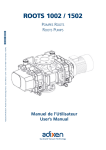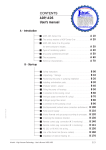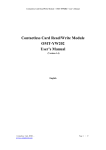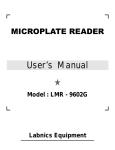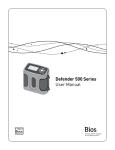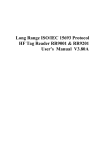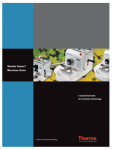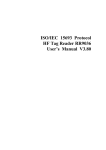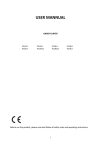Download AFLOW MF
Transcript
ELECTROMAGNETIC FLOW METER AFLOWT MF OPERATION MANUAL 9001:2008 Saint-Petersburg, Russia *** VZLJOT JSC quality management system is certified to ISO 9001:2008 *** Vzljot JSC Postal address: Masterskaya Str., 9, 190121, Saint-Petersburg, RUSSIA Tel.: +7 (812) 714-81-62 Fax: +7 (812) 714-71-38 E-mail: [email protected] URL: http://www.aflowt.com VZLJOT JSC provides free consultation services and personnel training ©VZLJOT JSC 2 TABLE OF CONTENTS INTRODUCTION.....................................................................................................3 1. DESCRIPTION AND OPERATION .....................................................................5 1.1. Application .............................................................................................5 1.2. Specifications.........................................................................................5 1.3. Contents of the delivery package...........................................................7 1.4. DESIGN AND OPERATION ..................................................................8 1.4.1. Operation principle ..................................................................................8 1.4.2. Operation modes.....................................................................................8 1.4.3. Displaying results ....................................................................................9 1.4.4. Service functions...................................................................................12 1.4.5. Design ...................................................................................................12 1.5. Marking and sealing.............................................................................14 2. OPERATION .....................................................................................................15 2.1. Operating restrictions...........................................................................15 2.2. Selecting nominal size .........................................................................16 2.3. Preparing for operation ........................................................................18 2.4. Operation .............................................................................................19 2.5. Troubleshooting ...................................................................................19 3. MAINTENANCE ................................................................................................20 4. STORAGE AND TRANSPORTATION ..............................................................21 APPENDIX A. View of the flowmeters...................................................................22 APPENDIX B. General-purpose outputs, circuit diagram of output stages............27 APPENDIX C. Factory configuration settings ........................................................28 3 This document describes design and operation of AFLOWT MF electromagnetic flowmeter (hereinafter referred to as the flowmeter) of MF-420(520)L and MF-420(520)F versions. LIST OF ABBREVIATIONS DN - Nominal Diameter MU - Measuring Unit FS - Flow Sensor EFM - Electromagnetic Flowmeter. 4 1. DESCRIPTION AND OPERATION 1.1. Application AFLOWT MF is an electromagnetic flowmeter designed to measure average volumetric flow rate and volume of hot and cold water as well as other electrically conductive liquids in wide temperature and viscosity ranges. AFLOWT MF flowmeter designed for power industry, municipal engineering and many other applications is mainly used as part of heat metering systems, measuring and monitoring systems and automatic process control systems. The flowmeter may be tailored to measure characteristics of reverse flow including output of flow direction sign according to the needs of a certain customer. 1.2. Specifications 1.2.1. Specifications are listed in Table 1. Table 1 Parameter 1. Nominal Diameter, DN, mm 2. Maximal measured average volumetric flow rate, Qmax, m3/h 3. Minimal measured average volumetric flow rate, Q min , m 3 /h 4. Pipeline pressure, MPa Value 20 25 32 40 50 100 150 200 10 16 25 40 63 250 630 1000 2500 Q max / 160 no more than 2.5 5. Specific conductivity of medium, S/m no less than 5·10 6. Temperature of medium, °C from 0.1 to 90 7. Power supply voltage, V 8. Power consumption, W 9. Mean time to failure, h -4 24 (see section 1.2.3) no more than 2.0 (MF-420L, F versions) no more than 2.5 (MF-520L, F versions) 75 000 10. Mean life time, years 12 5 300 1.2.2. Accuracy class 2. Limits of permissible relative error for recording time of totalizer operation are within ± 0.1 %. 1.2.3. The flowmeter is powered from a stabilized (18…25) V DC voltage source with pulse level of no more than ± 1.0 %. 1.2.4. The flowmeter relates to Environmental class B, C 1.2.5. View, overall dimensions and weight are given in Appendix A. 6 1.3. Contents of the delivery package Items of the delivery package are specified in Table 2. Table 2 Item Flowmeter RS-232 adaptor with cables Installation kit Equipment Certificate Operating documentation: - User manual - Installation manual Qty Notes 1 1 1 1 1 Note 1,2 Optional Note 3 NOTES 1. Flowmeter's design version and nominal diameter are specified in the purchase order. 2. The flowmeter is delivered in standard configuration. The factory configuration settings listed in Appendix C may be changed on customer's request. 3. Gaskets, power cables and signal cables are included in the standard supply. Cable length is customer selectable. Standard length for power cables is 1.5 m. "Multipurpose viewer" software package with “AFLOWT MF" program is used to process data on a PC via RS-232 Serial Interface. 7 1.4. DESIGN AND OPERATION 1.4.1. Operation principle The flowmeter comprises an electromagnetic flow sensor (FS) and a microprocessor measuring unit (MU). Operation principle is based on measuring electromotive force induced in electrically conductive liquid when it moves in magnetic field. The magnetic field is furnished in the inner channel of the flow sensor's flow tube by a special electromagnetic system. 1.4.2. Operation modes The flowmeter operates in three modes: - "ADJUSTMENT": adjustment and calibration - "SERVICE": start-up procedures - "OPERATION": user mode. Flowmeter's operating modes are set by placing (removing) jumpers on J5 and J6 terminals, which are located on the MU board (see Fig. A.5). Combinations of jumpers with regard to operating modes are specified in Table 3 ("+" means that the terminal contacts are closed by a jumper, and "-" means that the terminal contacts are opened). Table 3 Mode Terminal J5 J6 ADJUSTMEN + – SERVICE – + OPERATION – – Mode description Adjustment and calibration Start-up procedures Work In different operating modes the user can modify different device’s settings. The settings are reconfigurable via optional RS-232 serial interface. In the "ADJUSTMENT" mode, all of the settings may be changed. The mode is used to configure the device during manufacture and calibration. In the "SERVICE" mode, the following settings may be configured: - Flow measurement cutoffs - Settings and operation modes for general-purpose outputs - Display-related settings. In the "OPERATION" mode, only the display-related settings may be modified: set of displayed parameters, period for displaying a parameter, measurement units, and display cutoff. Configuration settings that may be modified in the OPERATION and SERVICE modes have no effect on the device's metrological characteristics and may be performed on site. In the "SERVICE" and "OPERATION" modes, adjustment and calibration settings are inaccessible. 8 1.4.3. Displaying results 1.4.3.1. Display Table 4 specifies the parameters that may be displayed on the flowmeter's display. Table 4 Symbol Q V V+ VT Parameter Units Average volumetric flow rate Totalized volume Totalized volume of forward flow Totalized volume of reverse flow Time of totalizer operation Number of digits indicated integral part fractional part m3/h Up to 7 Up to 6 m3 Up to 4 3 m3 Up to 4 3 m3 Up to 4 3 hour : min hour up 5 (hour) Up to 6 2 (min) 2 NOTES 1. Totalized volume is the algebraic (considering the sign of the flow) sum of the flow volumes totalized for both forward (positive) and reverse (negative) flows. For unidirectional flowmeters, the “Totalized volume” value equals the “Totalized volume of forward flow” value. 2. Reverse flow flowrate and volume along with the negative values of total volume are indicated by negative sign. 3. When a totalized value exceeds maximum, the totalizer rolls over, and counting starts from zero. The MF-520L,F flowmeters are equipped with a seven-segment two-line 8-character LCD with decimal point (Fig.1). The lines are as follows: - Alphanumeric data line - Marker line. The marker displayed as “V” character indicates the parameter, the value of which is being displayed. The parameter symbols stenciled on the device's front panel are located under the flowmeter's display. Fig.1. View of the display showing the value of reverse flow volume (V- = -122.7 m3). 1.4.3.2. The set of displayed parameters, period of displaying and display cutoff value may be set at the factory on customer request or on site when 9 putting the flowmeter into operation. Period of displaying is the time for displaying a parameter that may be set from 1 to 100 s. 5 s is a factory set value. Alarm pipeline conditions detected by the flowmeter or flowmeter's faults are indicated by “Н” character that is periodically displayed on a position related to specific error type. The types of errors detected and corresponding positions of the marker are described in section 2.5 of this manual. 1.4.3.3. General-purpose outputs The flowmeter has two galvanically isolated outputs. These outputs are versatile both with regard to operating mode (frequency, pulse or logical) and function. Operation modes, function and settings for the outputs are configured at the factory. Configuration may be performed on site when putting the device into operation. ♦ In the pulse and frequency modes, measured signal is taken from a general-purpose output in the form of square pulse sequence with period-to-pulse duration ratio of 2 and standardized pulse weight. The maximum pulse repetition rate is 2000 Hz. Output conversion coefficient Kp (pulse/l) that defines the pulse weight may be set within the range from 0.0001 to 200 000 (with 0.0001 increment). To determine the Kp value having regard to the maximal flow rate in the pipeline where the flowmeter is installed and frequency characteristics of the input receiving the pulse signal, the following formula may be used: 3 3.6 × F 1.8 × 10 К р [pulse / l] ≤ = , Qmax Qmax × τ pls where Qmax is the maximal operational flow rate in the pipeline, m3/h; F is the maximal flowmeter’s pulse repetition rate permissible for a receiving input, Hz; τpls = Tpls/2 is the minimal flowmeter’s pulse duration permissible for a receiving input, ms; Tpls is the pulse repetition period for the pulses on the flowmeter's output, ms. ♦ In the frequency operation mode, frequency is proportional to average volumetric flow rate measured over previous 80 ms. For the frequency mode, in addition to the Kp (“Conversion coefficient”), the values for “Max frequency”, “Alarm frequency” and “Active level” parameters should be selected. “Max frequency” is the frequency of output signal corresponding to maximal flow rate in the pipeline. If the Max frequency value is exceeded, this is identified as an alarm condition, i.e. the value of Kp set for this output is incorrect. “Alarm frequency” is the pulse repetition rate of a pulse sequence (no more than 2000 Hz) generated on the output, if the measured flow 10 rate exceeds Qmax specified for a given flowmeter. The value set for the Alarm frequency must be no less than the Maximal frequency value. To disable the Alarm frequency function, set 0 for the Alarm frequency parameter. “Active level” is the signal level (“Low” or “High”) related to the presence of a pulse. The electrical parameters for signal level are specified in Appendix B. “Q, absolute value of flow”, “Q+, Direct flow” and “Q-, Reverse flow” are the parameters that define function of the output in the frequency mode. If “Q, absolute value of flow” is activated, a pulse sequence with pulse repetition rate proportional to the measured flow rate is generated on the output regardless of flow direction. Selection of “Q+, Direct flow” setting means that the pulse sequence is only generated for forward flow, active “Q-, Reverse flow” setting means that the pulse sequence is only generated for reverse flow. ♦ If the pulse mode with 1s period is set, a burst of pulses generated on the output contains the number of pulses (considering pulse weight) related to the flow volume measured over a previous second. For the pulse mode, parameters to be configured are: “Conversion coefficient”, “Pulse period” and “Active level”. “Pulse period” is the pulse repetition period in a burst. It may be set from 1 to 255 ms, which relates to pulse repetition rate from 1000 to 4 Hz. “V”, “V+” and “V-“ are the parameters that define function of the output in the pulse mode. If “V” is activated, pulses the number of which is proportional to the measured volume are generated on the output regardless of flow direction. Active “V+” means that pulses are only generated for direct flow, active “V-“ means that pulses are only generated for reverse flow. ♦In the “State” (Logic) mode, one signal level on the input corresponds to the “event” state (or its specific condition) and the other level corresponds to the “no event” state (or another condition). For the logic mode, “Active level” is the parameter to be configured, which corresponds to the "event" state. To set function of the output in the logic mode, the following options may be selected: - “Flow direction” – signal level on the output is changed without lag on changing flow direction; “Active level” corresponds to direct flow - “Error Q>Qmax” – signal level on the output is changed, if the measured flow rate exceeds Qmax specified for DN of a given flowmeter - “Any error” – signal level on the output is changed in case of any alarm situation detected by the flowmeter 11 - “Reverse flow” – signal level on the output is changed only if the actual time of changing flow direction exceeds the preset time lag; the value of T lag is set from 0 to 60 min; “Active level” corresponds to direct flow - “Supply control” – High signal level is generated, if power is applied to the flowmeter. In case of power supply failure output signal is absent. CAUTION! In bidirectional flowmeters, flow and volume values are determined without regard for time lag for either direct or reverse flow. ♦ To match the outputs to inputs of different types, the output stage of a general-purpose output may be powered either from the internal power source (active mode) or external power source (passive mode).Circuit diagram of the output stage and description of its operation modes are given in Appendix B. Cable length for the general-purpose outputs operating in the pulse and frequency modes shall be up to 300 m. Factory set configuration settings are listed in Appendix C. If you require to change the settings, specify the new values in the purchase order. The configuration settings may be modified on site from "AFLOWT MF" program via RS-232 adaptor. Connection of the adaptor is described in the Installation manual. 1.4.4. Service functions The flowmeter enables you to set thresholds for suppressing flowrate measurement: “Rising” , “Falling” and “Display cutoff, % Qmax”. “Rising” and “Falling” cutoffs are the flowrate thresholds below which (on increasing or decreasing the flowrate value respectively) the device stops to totalize volume and output pulses. All flowrates are displayed as zeroes. “Display cutoff, % Qmax” is the flowrate threshold below which the flowrate value is displayed as zero, however the device continues to totalize volume and output pulses. Values for all cutoffs may be set from 0 to 0.255⋅Qmax in 0.001⋅Qmax increment. For a bidirectional flowmeter, the cutoffs operate either for positive or for negative flow. Flow direction signal is also changed according to the preset cutoffs. Factory set values for the cutoffs are specified in Table C.4 of Appendix C. 1.4.5. Design Design of the flow sensor depends on pipe connection type and may be as follows: - Wafer connection type (DN20-DN150): the FS is fixed by studs between the flanges welded to the pipeline ends - Flanged type (DN20-DN300): the FS's flanges are fixed to the mating flanges of the pipeline by bolts. 12 Design type of the FS is indicated in the design version name by the following letters: L – wafer pipe connection type, F – flanged type. For MF-420(520)L flowmeters, flow tubes of DN20-DN50 nominal sizes are all-polymeric and DN100, DN150 flow tubes have fluoroplastic liner inside. To protect projecting part of fluoroplastic liner from damages during mounting and operation, flow sensors designed for wafer pipe connection type are equipped with protection rings. For MF-420(520)F flowmeters, flow tubes of all standard sizes are lined with fluoroplastic. Flow sensors for DN20-DN150 sized MF-420(520)L flowmeters are manufactured in a polymeric case with a stand. The case consists of the halves fixed together by 4 screws. Flow sensors for DN100, DN150 nominal sizes come in a one-piece metal case with a stand. Flow sensors for flanged MF-420(520)F flowmeters come in a metal case with a stand regardless of nominal size. The measuring unit has a polymeric case fixed to the hollow stand of the FS. It is possible to turn the MU about stand axis by 90° or 180° (factory-installed on customer’s request). The power supply cable and two signal cables are entered into the case through two cable glands of standard Pg7 size. If necessary (for convenience of reading the MU display), the MU front panel may be set on the unit at an angle of ± 90° or 180°.To do this, unscrew four fixing screws and place the panel in the desired position (disconnection of the flexible flat cable is not required). The screw on the MU case is used as a grounding terminal. The wires for connection with the pipeline mating flanges are fastened to the screw. 13 1.5. Marking and sealing 1.5.1. The front panel of the Measuring Unit bears: - Name and identifier - Manufacturer’s trademark - Sign of the Type Approval Certificate - Design version - DN - Power supply voltage. The serial number is indicated on the nameplate located on the MU case. The power cable through is marked as "=24 V". 1.5.2. The terminal used to enable modification of calibration settings may be sealed after calibration. 1.5.3. The terminal used to enable modification of service settings may be sealed after completion of start-up procedures. In addition, the cover of the measuring unit may be sealed to protect the device from unauthorized access during operation. 14 2. OPERATION 2.1. Operating restrictions 2.1.1. Environmental operating conditions are in conformity with Environmental class B, C. 2.1.2. The flowmeter may be mounted into the pipeline installed horizontally, vertically or obliquely. Special filters or dirt traps are not needed. 2.1.3. For precision and reliable operation, when choosing the FS mounting location, consider the following conditions: - Air collection in the mounting location must be prevented - Liquid pressure in the pipeline must not be of values that may facilitate gas release - Straight pipe runs of appropriate length and nominal diameter equal to the nominal diameter of the EFM should be provided upstream and downstream the EFM. The runs must not include devices or components that may disturb flow structure - When the flowmeter is operated, the flow tube must be fully filled with liquid. Intensity of external magnetic field (commercial frequency) should not exceed 40 A/m. CAUTION! DO NOT touch the electrodes in the flow sensor's inner channel at any step of working with the flowmeter. Mounting considerations as well as mounting and dismounting instructions are given in “AFLOWT MF Electromagnetic Flowmeter, Installation instruction” document. For the FS with protection rings removed, DO NOT remove the tightening stud (bolt) and clamping plates for more than 10 minutes. 2.1.4. Type and composition of medium (suspensions and their concentration, impurity substances, etc.) and pipeline conditions must not lead to sediments affecting performance and metrological characteristics of the flowmeter. To provide proper operation of the flowmeters in pipelines equipped with carbon filters, it is necessary to keep the filters in good condition. 2.1.5. If needed, the mounting location is provided with grounding system and lightning protection system. 2.1.6. The requirements for mounting location and operating conditions specified in this manual are based on the most typical external factors affecting flowmeter’s performance The external factors that cannot be foreseen, evaluated or tested by the manufacturer may exist or appear on site. In this case, it is necessary to eliminate these factors or place the flowmeter in other location. 15 2.2. Selecting nominal size 2.2.1. Flowmeter’s nominal size is selected on the basis of flow rate range in the pipeline where the flowmeter is installed. If several sizes are suitable, the nominal size is selected from the specified limit of pressure losses. 2.2.2. If the selected flowmeter's nominal diameter (DN) is less than the nominal diameter of the pipeline, use pipe reducers (confusors and diffusors). 2.2.3. To evaluate hydraulic losses in the <confusor-FS-diffusor> system use the method represented in the Fig. 2. 2.2.3.1. The following initial values are used to evaluate hydraulic losses: - liquid volumetric flow rate in the pipeline -Q [m3/h]; - DN of the inlet pipeline - D1 [mm]; - DN of the FS - D2 [mm]; - DN of the outlet pipeline - D3 [mm]; - confusor taper angle - α1 [deg]; - diffusor taper angle - α3 [deg]; - length of the straight pipe run -/ [mm]. 1 – confusor; 2 – full bore ball valve; 3 – EFM; 4 – diffusor. Fig. 2. Pipeline with the flowmeter installed 2.2.3.2. Pressure losses hн in the <confusor-FS-diffusor > system are the sum of pressure losses in the confusor hн1, losses in the straight pipe run (length l) hн2, and losses in the diffusor hн3: Hydraulic losses in the confusor are determined according to graph (Fig. 3a), where v2 is the flow velocity in the straight pipe run. The graph of hydraulic losses as a function of flow velocity is calculated for confusor taper angle α1 = 20 °. To determine flow velocity by volumetric flow rate Q use the graph in Fig.4 or the formula: 3 v (m/s) = Q (m /h) 2 0,9 π × DN (mm) 16 ×10 3 Graph 3b is used to determine hydraulic losses in the straight pipe run. The graph of the hydraulic losses as a function of flow velocity corresponds to straight pipe run legnth-to-diameter ratio 15, 20; 25, and 30. Hydraulic losses in the diffusor are determined according to graph 3b. The Graph of hydraulic losses as a function of flow velocity is calculated for diffusor taper angle α3 = 20° and corresponds to diffusor’s maximal-to-minimal diameter 2.0; 2.5; 3.5, and 4.0. Fig. 3a Fig. 3b Fig. 3c Fig.3. Graphs of hydraulic losses in confusor (a), straight pipe run (b) and diffusor (c) 17 Fig .4. Graph of flow rate vs flow velocity for various DNs 2.3. Preparing for operation 2.3.1. Safety instructions 2.3.1.1. The flowmeter should only be used by personnel familiar with all operational documentation for the product. 2.3.1.2. When working with the flowmeter, the dangerous factors are as follows: - AC voltage (RMS value up to 264 V, frequency 50 Hz) - Pipeline pressure (up to 2.5 MPa) - Medium temperature (up to 150°C) - Other site-specific factors. 2.3.1.3. Do not use the flowmeter in the pipelines with pressure exceeding 2.5 MPa. 2.3.1.4. In the course of mounting, putting into operation or repair works you must not: - Make electrical connections to the flowmeter or switch over modes when the flowmeter is powered up; - Remove the EFM from the pipeline until pressure in the pipeline section worked on is fully released. 2.3.2. Preparing for operation When putting the flowmeter into operation check the following: - Flow is in the direction of the arrow located on the flowmeter's body - Inlet and outlet straight pipe runs correspond in length - The flowmeter and related equipment are connected in accordance with the selected wiring diagram - Operation modes and configuration settings of the flowmeter's outputs are correctly set and match the parameters of corresponding inputs - Power supply voltage corresponds to the specifications. 18 At the first power-up or after a long break in operation, the flowmeter becomes operational after: - All hydraulic processes in the pipeline related to changing flow rate (draining, filling, flow adjustment etc.) are fully completed - The FS is washed by medium for 30 minutes - The flowmeter is kept powered for 30 minutes. 2.4. Operation After putting into operation, the flowmeter works in the automatic mode. Measurement results are shown on the flowmeter's display (if applicable). In addition, measurement results and configuration settings may be read via RS-232 serial interface with use of the optional RS-232 adaptor. 2.5. Troubleshooting 2.5.1. The list of possible faults and alarm conditions detected by the flowmeter and indicated by "Н" character is given in Table 5. Position number of "H" character is read from left to right. Table 5 Position number 1 2 3 4 5 6 7 Explanation Device not initialized Measuring equipment failure Flow rate exceeds Qmax Repeated error during measuring Value of Kp on the output N2 not correct Value of Kp on the output N1 not correct Single error during measuring Notes for flow direction mode for frequency or pulse mode 2.5.2. If "Н" is displayed in positions 1 or 2, the flowmeter shall be forwarded for repair. 2.5.3. If "Н" is displayed in other positions and/or in case of no pulses on a general-purpose output, check the following: - Power supply voltage comes from the secondary power source and conforms to the specifications - The power cable is reliably connected - Liquid is present and moves in the pipeline - Air is not collected in the place where the flowmeter is installed - The Kp and cutoff values are correctly set (change if necessary). If all the requirements listed above are met, contact the service centre (regional dealer) or manufacturer for the information about the device’s operability. 19 3. MAINTENANCE 3.1. It is recommended to check on regular basis that: - Flowmeter’s performance complies with the specifications - Operating conditions are met - Power supply voltage is present - No external defects are detected - Electrical and mechanical parts are reliably connected. Check periods depend on operating conditions but should not exceed two weeks. 3.2. If operating conditions specified in Environmental class B, C are not observed, this may lead to the flowmeter’s fault, or the permissible limits of relative measurement error may be impaired. External defects may also lead to deterioration in measurement accuracy. Therefore, when external defects of the flowmeter, power cable, or signal cable are detected, contact the Service Center or regional dealer for the information about the device’s operability. 3.3. During device’s lifecycle, it is necessary to check the inside of the flow sensor’s flow tube for dirt or/and sediment no less than twice a year. Slight layer of reddish sediment is permissible. The sediment shall be removed with a clean soft dump cloth. If dirt and/or sediment of other type or in considerable amount is detected, it is necessary to clean the surface of the FS and send the flowmeter for unscheduled calibration. In this case, it is recommended to clean the flow sensor immediately after removing it from the pipeline with a clean cloth moistured in water and non-abrasive detergent. 3.4. Before dispatching the flowmeter for calibration or repair, after dismounting clean the inside of the flow tube from sediment and liquid residues. The flowmeter is mounted and dismounted according to the instructions specified in the Installation manual for the flowmeter of a given design version. Please specify post details, phone/fax numbers along with the way and address for redispatching in the documents forwarded to the manufacturer along with the flowmeter. 20 4. STORAGE AND TRANSPORTATION 4.1. The flowmeter should be kept in the manufacturer's box in a dry heated storeroom. The storeroom should be free from current-conductive dust, acid or alkali fumes and aggressive gases. During storage the flowmeter does not require any special maintenance. 4.2. The flowmeters can be transported by road, rail, sea or air provided that the following requirements are met: - The flowmeter is transported packed in the manufacturer’s box - Protection against moisture is provided - Temperature is within the range of - 30 to + 50 °C - Humidity does not exceed 98 % at + 35 °C - Vibration is within the range of 10-500 Hz with maximum 0.35 mm amplitude or 49 m/s2 acceleration - Impact acceleration does not exceed 98 m/s2 - The flowmeters are fixed to prevent damages. 21 APPENDIX A. View of the flowmeters * - reference dimension 1 – Display (if applicable); 2 – Measuring Unit; 3 – Flow Sensor; 4 – Signal cable gland; 5 – Power cable gland; 6 – Wires for connection between the EFM case and pipeline; 7 – Electrodes. DN, mm D*, mm H*, mm L*, mm H*, mm 20 25 32 40 50 50 58 65 75 87 81 81 90 98 110 113 113 123 133 153 188 188 196 204 216 Weight, no more than, kg 0,78 0,85 1,04 1,24 1,61 Fig. A.1. View of the MF- 420(520)L flowmeter, DN20…DN50 nominal sizes (polymeric flow tube) 22 * - reference dimension 1 – Display (if applicable); 2 – Measuring Unit; 3 – Flow Sensor; 4 – Protection rings; 5 – Signal cable gland; 6 – Power cable gland; 7 – Wires for connection between the EFM case and pipeline; 8 – Electrodes. DN, mm D*, mm D1*, mm L*, mm H*, mm 100 150 149 202 159 219 214 233 284 344 Weight, no more than, kg 9,35 15,55 Fig. A.2. View of the MF- 420(520)L flowmeter; DN100, DN150 nominal sizes (flow tube with fluoroplastic liner) 23 * - reference dimension 1 – Display (if applicable); 2 – Measuring Unit; 3 – Flow Sensor; 4 – Signal cable gland; 5 – Power cable gland; 6 – Wires for connection between the EFM case and pipeline; 7 – Electrodes. DN, mm D*, mm D1*, mm L*, mm H*, mm 20 25 32 40 50 100 150 50 58 66 75 87 149 202 105 115 135 145 160 230 300 150 150 194 194 195 244 316 212 217 233 241 255 320 384 Weight, no more than, kg 3,8 4,1 5,8 7,0 8,9 20,0 36,4 Fig. A.3. View of the MF- 420(520)F flowmeter, DN20…DN150 nominal sizes (flow tube with fluoroplastic liner) 24 * - reference dimension 1 – Display (if applicable); 2 – Measuring Unit; 3 – Flow Sensor; 4 – Protection rings; 5 – Signal cable gland; 6 – Power cable gland; 7 – Wires for connection between the EFM case and pipeline; 8 – Electrodes. DN, mm D*, mm D1*, mm L*, mm H*, mm 200 300 257 360 358 485 362 514 440 557 Weight, no more than, kg 59,0 121 Fig. A.4. View of the MF- 420(520)F flowmeter, DN200, DN300 nominal sizes (flow tube with fluoroplastic liner) 25 XP1 – connector for display flexible flat cable or RS-232 adaptor cable; XS1 – DC 24 V power supply connector; XT2 – general-purpose output N1 terminal block; XT2 – general-purpose output N2 terminal block; J1, J3 – terminals used to set operation modes for general-purpose output N1; J2, J4 – terminals used to set operation modes for general-purpose output N2; J5 – terminal used to enable modification of calibration settings; J6 – terminal used to enable modification of service settings; XP2, XT1, XT5 – service terminal blocks. Fig. A.5. View of the Measuring Unit board 26 APPENDIX B. General-purpose outputs, circuit diagram of output stages Output stages of the general-purpose outputs have the same circuit design outlined in Fig. B.1. Terminals pins and signals for N2 generalpurpose output are specified in brackets. Fig. B.1. General-purpose outputs, circuit diagram of output stages For the “Active level”– “High” setting, "pulse" state in the frequency and pulse modes or "event" state in the logic mode corresponds to the open switch. "No pulse" and "No event" states correspond to the close switch. For the “Active level”– “Low” setting, the output states and switch states are related inversely. To set the active power supply mode for an output stage, it is necessary to connect the output stage to the internal +5 V power source by placing jumpers between J1 and J3 terminals on the flowmeter's board (for general-purpose output N1), and between J2 and J4 terminals on the flowmeter's board (for general-purpose output N2). In the active power supply mode, the open switch state relates to output voltage in the range of (2.4 – 5.0) V, the close switch state corresponds to output voltage of no more than 0.4 V. External load resistance shall be 1 kOhm as a minimum. The passive power supply mode means powering from an external power source with output DC voltage up to 24 V. Permissible value of external load current is maximum 10 mA. Length of signal cables should be no more than 300 m. 27 APPENDIX C. Factory configuration settings Table C.1. Unidirectional flowmeter General-purpose General-purpose output N1 output N2 Parameter 1. Operation mode 2. Function 3. Conversion coefficient, Kp 4. Flow cutoffs 5. Max frequency Bidirectional flowmeter General-purpose General-purpose output N1 output N2 Frequency Frequency Q, direct flow Q, absolute value of flow As per Table C.2 As per Table C.3 State (Logic) Reverse flow As per Table C.2 As per Table C.4 200 Hz 1600 Hz As per Table C.4 200 Hz 6. Alarm frequency 0 Hz 0 Hz 7. Active level Low Low ----------------Active ----------------- 8. Tlag 9. Power supply mode ----------------------------------------------------------------Low * 10 min Active * - for direct flow Table C.2. DN, mm Kp, pls/l 20 50 25 32 32 20 40 12,5 50 8 100 2 150 0,8 200 0.5 300 0.2 150 6,25 200 4 300 1,6 Table C.3. DN, mm Kp, pls/l 20 400 25 250 32 160 40 100 50 62,5 100 16 Table C.4. Design version MF-420(520)L, F Cutoff 0.002⋅Qmax Table C.5. Cutoff values for various nominal diameters 20 25 32 40 DN, mm 50 100 150 200 300 3 0.002⋅Qmax m /h 0,027 0,014 0,042 0,021 0,070 0,109 0,679 1,528 2,716 6,112 0,035 0.001⋅Qmax m3/h 0,054 0,085 0,340 0,170 0,764 1,358 3,056 re_er.x20LF_doc3.4~(trans) 28





























